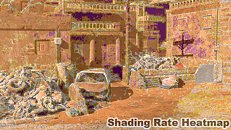Thursday, December 5th 2019

UL Benchmarks Outs 3DMark Feature Test for Variable-Rate Shading Tier-2
UL Benchmarks today announced an update to 3DMark, with the expansion of the Variable-Rate Shading (VRS) feature-test with support for VRS Tier-2. A component of DirectX 12, VRS Tier 1 is supported by NVIDIA "Turing" and Intel Gen11 graphics architectures (Ice Lake's iGPU). VRS Tier-2 is currently supported only by NVIDIA "Turing" GPUs. VRS Tier-2 adds a few performance enhancements such as lower levels of shading for areas of the scene with low contrast to their surroundings (think areas under shadow), yielding performance gains. The 3DMark VRS test runs in two passes, pass-1 runs with VRS-off to provide a point of reference; and pass-2 with VRS-on, to test performance gained. The 3DMark update with VRS Tier-2 test will apply for the Advanced and Professional editions.
DOWNLOAD: 3DMark v2.11.6846
DOWNLOAD: 3DMark v2.11.6846



58 Comments on UL Benchmarks Outs 3DMark Feature Test for Variable-Rate Shading Tier-2
The tech inherently gets its performance through lowering image quality, the question is, if its improvement in performance can be had at a low price in said image quality.
A single promotional shot is not really proof.
If it holds true though, its good news for 4K and VR on hardware people can actually afford, in light of the pricing on the high end as well as enthusiast-level stuff in recent years.
The sad fact is that AMD don't support this DX12 feature and with AMD having current gen and next-gen exclusivity, I doubt many game devs will bother putting the extra work in for only a fraction of a fraction of a fraction of their target market.
I dunno, given the PC vs Console marketshare, and then given the AMD vs Nvidia PC marketshare, and then given the marketshare of Nvidia PC GPUs that support this feature, I suspect it's not even worth a second glance for most devs.
The minute AMD support this, it'll gain momentum because consoles are all about squeezing the best performance out of fixed hardware.
microsoft.github.io/DirectX-Specs/d3d/VariableRateShading.html
Easy VRS Integration with Eye Tracking
Given how popular it still is and the fact that it hardly has more rasterization features than Maxwell.
So nothing really to get excited about
They minized the overhead and optimized pipeline via Async Compute.
www.leiy.cc/publications/nas/nas-gdc19.pdf
microsoft.github.io/DirectX-Specs/d3d/VariableRateShading.html
With RDNA2 they'll again have stuff we already knew. The real question is what Nvidia will have by then...
RT cores
Tensor cores
simultaneous int32+fp32 (amd can do 16+16)
vrs
mesh shading